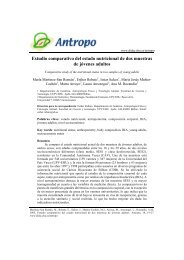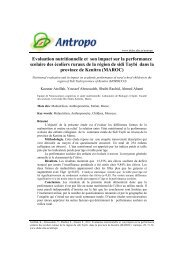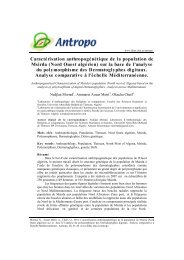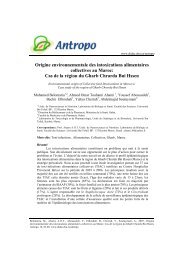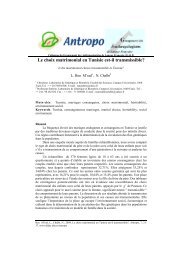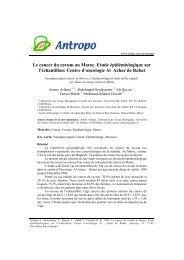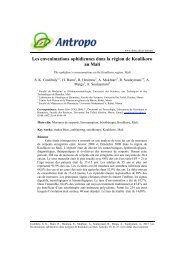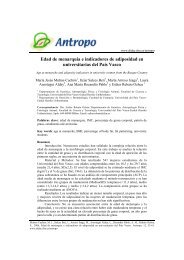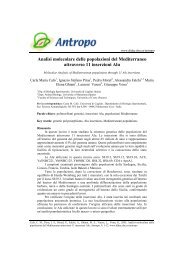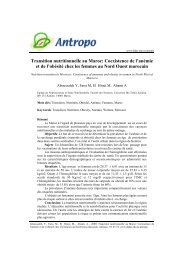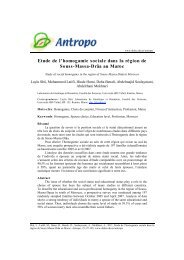des populations Berbères et peuplement du nord de l'Afrique - Antropo
des populations Berbères et peuplement du nord de l'Afrique - Antropo
des populations Berbères et peuplement du nord de l'Afrique - Antropo
- No tags were found...
You also want an ePaper? Increase the reach of your titles
YUMPU automatically turns print PDFs into web optimized ePapers that Google loves.
Coudray <strong>et</strong> al., 2006. <strong>Antropo</strong>, 11, 75-84. www.didac.ehu.es/antropo1989; Ferembach, 1985). Elle pourrait aussi avoir eu lieu au cours <strong>de</strong> la diffusion Néolithique<strong>de</strong>puis le Proche-Orient, il y a 10 000 ans av. J.-C. (Ammerman <strong>et</strong> Cavalli-Sforza, 1984).Au Maroc, on constate qu’il n’y a pas <strong>de</strong> distinction génétique entre les <strong>populations</strong>berbérophones <strong>et</strong> arabophones. Ceci laisserait alors supposer que la conquête arabe a été, sur les<strong>populations</strong> marocaines, un phénomène principalement culturel avec l’Islamisation <strong>et</strong>l’Arabisation <strong>de</strong> certains groupes. Quand est-il alors <strong>de</strong> l’impact génétique ? En fait, n’ayant pas àce jour les outils pour mesurer l’impact génétique <strong><strong>de</strong>s</strong> migrants Arabes sur les <strong>populations</strong> <strong>nord</strong>africaines,on pourrait penser que c<strong>et</strong>te similarité génétique entre Arabes <strong>et</strong> Berbères était déjàprésente avant la conquête Arabe. On peut aussi imaginer qu’elle résulte, pour partie, d’unehomogénéisation <strong>du</strong> pool génique par échanges réciproques entre les diverses <strong>populations</strong>.Finalement, toutes ces observations semblent en accord sur le fait que les Berbères actuels portentles traces d’un <strong>peuplement</strong> <strong>nord</strong>-africain ancien qui a <strong>du</strong> affronter <strong>et</strong> subir les différentsévènements historiques, mais qui a su préserver dans les générations suivantes ses originalitésculturelles (notamment ses coutumes <strong>et</strong> la langue).Figure 4. Analyse en Composantes Principales: les Berbères <strong>et</strong> la base <strong>de</strong> données STR.Références pour les <strong>populations</strong> <strong>nord</strong>-africaines : Ara, Asn, Bou, Mar : Maroc (Bosch <strong>et</strong> al., 2001 ; Perez-Lezaun <strong>et</strong>al., 2000 ; Coudray <strong>et</strong> al., soumis) ; Tun, Kes, Zri : Tunisie (Cherni <strong>et</strong> al., 2005 ; Brandt-Casa<strong>de</strong>vall <strong>et</strong> al., 2003) ;Ada, Cpt, Egy, Siw : Egypte (Tahir <strong>et</strong> al., 2003 ; Dugoujon, résultats non publiés).Références pour les <strong>populations</strong> sub-Sahariennes : Guin : Guinée Bissau (Goncalves <strong>et</strong> al., 2002) ;Hut, Tut : Rouanda (Regueiro <strong>et</strong> al., 2004 ; Tofanelli <strong>et</strong> al., 2003) ;Ang : Angola (Beleza <strong>et</strong> al., 2004) ; Moz : Mozambique (Alves <strong>et</strong> al., 2004).Références pour les <strong>populations</strong> sud-ouest européennes: Esp : Espagne <strong>et</strong> Por : Portugal (Perez-Lezaun <strong>et</strong> al., 2000).Figure 4. Principal Coordinate Analysis: the Berbers and the STR database.References for North-African <strong>populations</strong>: Ara, Asn, Bou, Mar: Morocco (Bosch <strong>et</strong> al., 2001; Perez-Lezaun <strong>et</strong> al.,2000; Coudray <strong>et</strong> al., submitted); Tun, Kes, Zri: Tunisia (Cherni <strong>et</strong> al., 2005; Brandt-Casa<strong>de</strong>vall <strong>et</strong> al., 2003); Ada,Cpt, Egy, Siw: Egypt (Tahir <strong>et</strong> al., 2003; Dugoujon, unpublished results).References for sub-Saharan <strong>populations</strong>: Guin: Guinea Bissau (Goncalves <strong>et</strong> al., 2002); Hut, Tut: Rwanda (Regueiro<strong>et</strong> al., 2004; Tofanelli <strong>et</strong> al., 2003); Ang: Angola (Beleza <strong>et</strong> al., 2004); Moz: Mozambique (Alves <strong>et</strong> al., 2004).References for South-West European <strong>populations</strong>: Esp: Spain and Por: Portugal (Perez-Lezaun <strong>et</strong> al., 2000).Remerciements. Nos remerciements s’adressent à toutes les personnes <strong>et</strong> infrastructures qui ont participé à la collecte<strong><strong>de</strong>s</strong> échantillons <strong>et</strong> l’acquisition <strong><strong>de</strong>s</strong> résultats. Ces recherches s’inscrivent dans le cadre <strong>du</strong> proj<strong>et</strong> EUROCORES <strong>de</strong>l’ESF (European Science Foundation), contrat no. ERAS-CT-2003-980409 <strong>et</strong> bénéficient <strong>de</strong> financements <strong>du</strong> CNRS(Centre National <strong>de</strong> la Recherche Scientifique) <strong>et</strong> <strong>du</strong> Conseil Régional <strong>de</strong> Midi-Pyrénées (Toulouse, France).81



